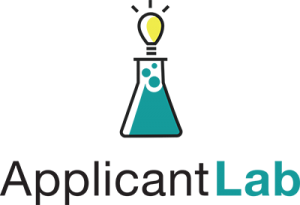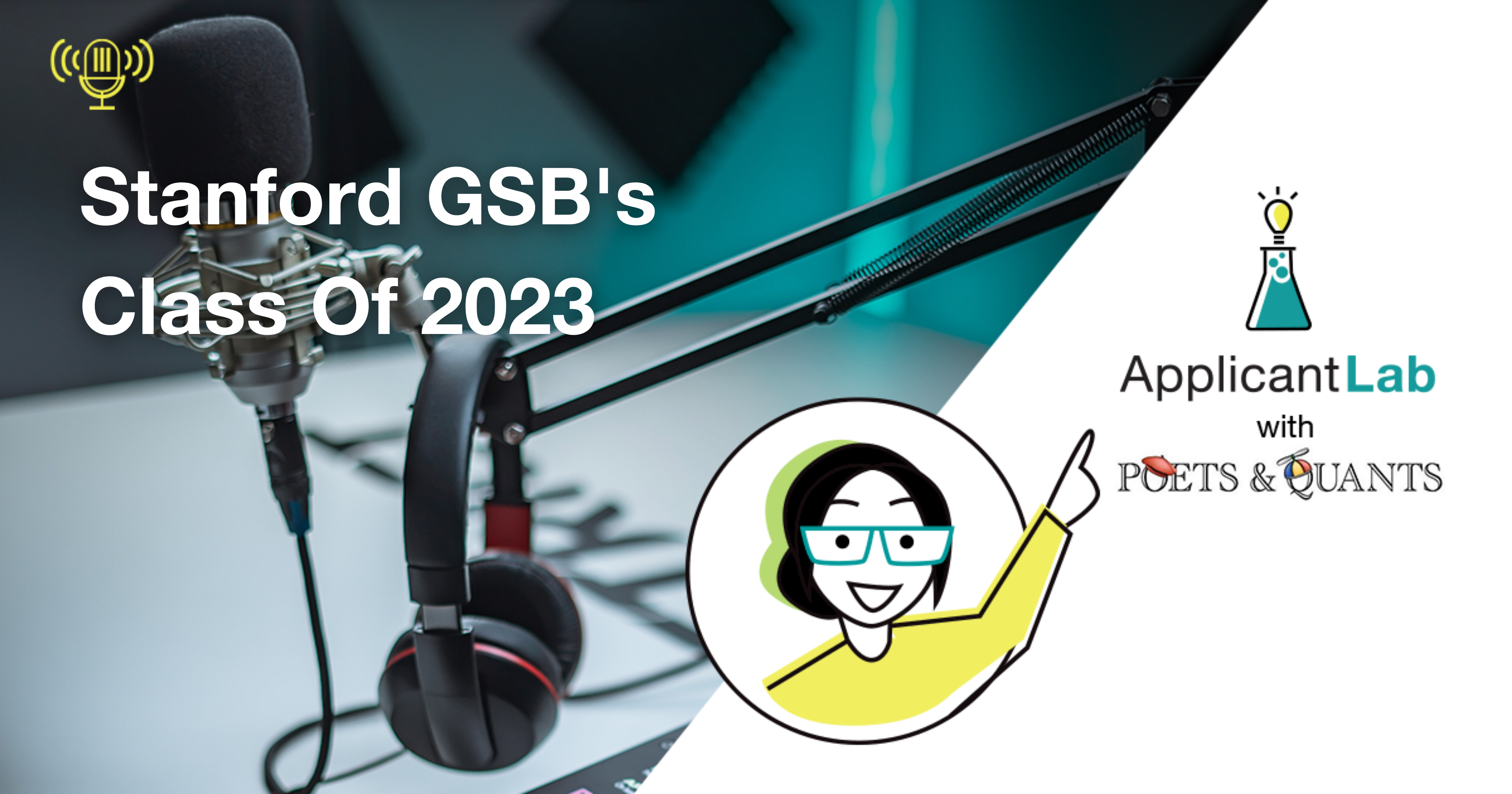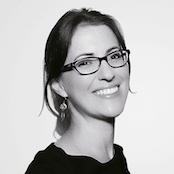The Stanford Graduate School of Business is one of the most prestigious MBA programs in the world. In this episode of Business Casual, Maria, John, and Caroline dig into the recently released stats for Stanford GSB’s Class of 2023 and use the data points to speculate on how the MBA landscape in the landscape for all business schools is likely to change.
Discussion items:
- Stanford GBS’s record high average GMAT score (738) and what that means for prospective applicants. Does the team think this discourages some potential applicants? Should it?
- How application volumes have trended recently and what makes Stanford different
- The hunt for “gender parity” in MBA admissions and how AdCom’s balance that objective with other diversity goals
- Why having “above average stats” (even with GBS’s high average) doesn’t guarantee you acceptance (and why the focus on stats is a double-edged sword)
Episode Transcript
[00:00:07.270] – John
Hello, everyone. This is John Byrne with Poets and Quants. We’re going to take a look at the latest class profile from the Stanford Graduate School of Business and talk about how it compares with Harvard and Wharton with My co hosts Caroline Diarte Edwards and Maria Wich Vila. Maria is the founder of Applicant Lab. Caroline, of course, is the cofounder of Fortuna Admissions and the former director of admissions at INSEAD. So we are going to talk a little bit about the new class profile at Stanford Graduate School of Business. There are some surprises in the numbers. If you’ve been reading quotes and quotes, you will know what those surprises are. But we’re going to put them into some context with Maria and Caroline. And then we’re also going to do a little bit of crystal ball gazing. We’re going to look five years, maybe even ten years ahead, and speculate on how the MBA landscape in the landscape for all business schools is likely to change. We’ve been through an incredibly disruptive time with the pandemic and the increase in the use of technology to deliver education. And so we want to just set aside a little bit of time to talk about okay, what are the long term trends here?
[00:01:19.120] – John
What does this look like over the next five to ten years? What are we going to see that’s different from today? First off, let’s talk about Stanford. So one surprise in the numbers at Stanford was the application volume. We also reported earlier, of course, that Harvard was up 5% in applications. Wharton was up two and a half. They tended to be on the low end of the schools that are reporting application increases. Michigan was up 50 plus percent, Indiana Kelly up 60 plus percent. You’ll note that there were 12% increases at Cornell at Yale, at Duke, at MIT, 11% at Dartmouth Tuck, and 10% at Georgetown McDonough. So Stanford is up less than 1%, which is something of a surprise. It’s actually 0.6%. And I think that’s an interesting number. And we’ll talk a little bit about why we think that maybe so. More importantly, perhaps, Stanford established a new class average GMAT record for any business school outside of a few schools in India where the GMAT’s are ridiculously high. They hit a 738, which is five points higher than the previous year when they hit a 733. The new score puts the class that just entered in the 97th percentile, the top 3% of all GMAT test takers in the world, which is really intriguing.
[00:02:56.520] – John
Now, Caroline, what do you make of this? I’m sure it’s not intentional.
[00:03:03.570] – Caroline
No. I mean, a higher GMAT score is average is a double edged sword, because the issue for schools is that whilst on one hand, it can be seen as a signal of quality, and no doubt it does speak to the incredibly qualified pool that Stanford enjoys every year and the competition amongst those candidates and how hard they’re working to prepare themselves for those tests would be quite incredible. But on the other hand, the schools are aware that that is also a deterrent, and it functions as a deterrent to some candidates from applying and some candidates who they would love to see in their pool. Right. You don’t have to have a GMAT of 730 or 740 to get into Stanford. And Stanford’s Admissions does not want you to have that perception. And I know that they’re concerned that sometimes they miss out on some great candidates because people self select out because they assume if they haven’t got a 737 40, then they’re just not in the game. So it is a signal of quality, of one aspect, of one limited aspect of quality. But it also does have some negative consequences for the schools.
[00:04:15.940] – Caroline
And it is interesting that has gone up at the same time as really stable application volume, really no significant change there. And I think that shows that those top schools just have an incredibly consistent pool of strong applications coming through year after year. And when there is, as we’ve discussed before, when there is variation, application volume, and suddenly people applying because there’s a change in circumstances, in this case, it’s a pandemic. In previous cycles, it’s just been a normal recession, economic downturn. More people throw their hat into the ring and those are not always the best qualified candidates or the very best quality candidates. So I think there has been a case here that the top schools have seen pretty steady volume and the schools that are still great schools, but not the M7 necessarily. The M7 schools have seen increased volume because of that sort of variable quality in that increased volume of applications that are coming through.
[00:05:23.650] – John
Yeah. In Caroline, it was only a few years ago that Kirsten Moss publicly said that she was worried that historically the highest in the world for an MBA program of any prestige. What was in fact discouraging people. They were at 737 for the entering classes in 2016 and 2017, and it dropped to 732 in 2018. And it was widely interpreted as Kirsten actually dropping the GMAT because of the comments that she made publicly that she felt it was discouraging many really good applicants from applying that year. In 2018, entering class, Wharton managed to tie Stanford for the average at 732. Since then, Wharton has fallen behind. And even though Wharton’s average went up by eleven points this year, which would have equaled last year’s GMAT average at Stanford, Stanford managed to increase by five. So they stay ahead. It’s also noteworthy that on every other level, GRE scores as well as GPA, Stanford is number one in the world. Their GPA this year is 3.78. The GRE is even up a point. On the quant side, these numbers tend to matter if you care about rankings. I don’t think Stanford cares all that much because rankings really don’t determine application volume or interest at Stanford.
[00:07:00.190] – John
But Wharton certainly seems to be very conscious of that. Maria, do you think a 738 might discourage applicants?
[00:07:09.300] – Maria
I agree with Caroline that I think it discourages certain applicants, but I also think it has the opposite effect where sometimes when we emphasize so much these quantitative data points, someone who has like a 740 but is otherwise completely unremarkable will say, I’m above the average of Stanford here I come.
[00:07:29.270] – John
Right?
[00:07:29.860] – Maria
Then it becomes like this huge disappointment for them. So it’s great that the school it’s funny because they’re all like, well, it’s a holistic process. If it’s such a holistic process, then why is it that you happen to have the highest GMAT score every year? That’s weird. You would think that it would fluctuate and it would be a lot more ups and downs between that. I wish that for all the emphasis on the GMAT, that they would also publish other data. I don’t know, like how many people in our class were promoted early by their firms, how many people in our class had PNL experience? How many people in our class, if they came from an analyst, like a ranked analyst program, how many people were in the top 1% of analysts in their analyst class or whatever? I wish they would also provide other metrics in terms of the quality of the candidates, because a 740 GMAT is not going to get you into Stanford. A 680 might get you in if you were helping a company launch its operations in Italy. And you know what I mean, you’ve knocked it out of the park.
[00:08:32.450] – Maria
So it’s just I wish that they would either not focus on this stuff at all or if that’s unavoidable because of the rankings dog and pony show, then at least provide other data a little bit more like, hey, yeah, 740 is great. But also it would be really cool if you were a top performer and if you had convinced a company to change direction or if you had convinced a local government to implement a new service that supports women entrepreneurs or a little bit more data like that. Because I think when you report simplistic data, you get simplistic judgments from applicants that sometimes are not beneficial.
[00:09:11.910] – John
Yeah, that’s really a good point, because those other data points that you suggested reporting would really help a lot of people, frankly, and would certainly confirm the quality overall of the entering classes at some of the top schools. And Stanford does report, for example, first generation College students. They’re saying, for example, that the students who were the first in their family to graduate from four year College or University this year went up by a third to 12% of the class, up from 9% a year earlier. And what’s interesting to me about that stat, and I think you’ve mentioned this in earlier podcast, Maria, sometimes if you admit, let’s say, white students from socioeconomic backgrounds that weren’t privileged. You kind of don’t get credit for that. And you probably should in diversity terms, because the school also reported increased black American students by 43% this year to 10%, up from seven. Asian-Americans were increased by 30% to almost a third of the class, and Hispanics rose about 9% to compose 12% of the incoming students. So there’s a lot of attention being paid, obviously, to the racial and ethnic diversity of the class. That is true at all business schools today in the US, where this has become a really hot issue.
[00:10:41.510] – John
The other interesting thing is that while Harvard and Wharton considered the peer schools to Stanford for sure, hit record levels of women in the class, Stanford was down on women, 44% of the incoming students are female, down for 47% a year earlier. And that’s when Wharton, you’ll recall, exceeded gender parity with record 52%, and Harvard achieved a record of 46%. Now there is a whole lot of difference from Harvard at 46 and Stanford at 44, even though it’s a three percentage point decline for Stanford from the year earlier. What do you make of that, Maria? Why do you think? Because you got to know they were aiming to get closer to the gender parity, having been only three percentage points below it last year.
[00:11:34.310] – Maria
Caroline could probably talk to this infinitely more than I can. I mean, it’s an imperfect thing. They might have given offers to 50% of women, 50% women, 50% men offers, but maybe for whatever reason, women chose to go someplace else. So you can try as hard as you want to kind of engineer some of these things. But I also think at the end of the day, and especially if we’re talking about Stanford, which has a relatively small class, I haven’t done the math. I do not have my Excel spreadsheet open right now. But if we’re talking a 3% difference, we’re probably not talking less than 1012. I don’t know. Gosh, I should have opened the Excel spreadsheet before I started talking at this point. But the point is we’re not talking about like it’s not like 100 women these fluctuations. It’s silly.
[00:12:25.650] – John
Yes, because there are only what is it, 436 students? Something like that in Stanford’s class. I think that’s what the number is exactly.
[00:12:38.710] – Maria
Yeah, we’re talking about 13 students would be a 3% class of 13 students.
[00:12:46.170] – John
To me, in a way, it does speak to you. You put your finger on one lever and it affects other levers. So if you want more black American students, more Hispanics, more Asian Americans, you want more internationals, because of course they increase. You want more first generation College students. Maybe something else is going to just go off kilter. I can imagine that, Caroline, when you were managing the numbers at INSEAD, this kind of thing happened where you try to increase something and then obviously something else falls.
[00:13:19.920] – Caroline
Yeah, there’s a lot of variables to manage at the same time. And yeah, it’s definitely the case that yield is typically lower on women admits versus male admits because there’s just more competition amongst the top schools for those fantastic women candidates. So I’m sure that’s the case that they had made an equivalent number of offers to female candidates as the men, but their yield would have been lower. Yes.
[00:13:47.890] – John
The other thing we don’t know is the financial incentives. Right. Because if you increase racial and ethnic diversity in the school, when you don’t increase gender diversity, you might presume that more of the financial rewards are going to the diverse candidates to get them to come because they’re less likely to have savings and money or want to take out big loans. To the extent that you only have available pool of scholarship money and then you shovel more to get the racial and ethnic diversity, you might hurt the gender diversity.
[00:14:20.610] – Caroline
Yeah, that’s true. Although I think the top schools don’t have too much of an issue with the depth of their pockets. But I do think that sometimes female candidates are more sued by scholarship offers than male candidates. I have seen that in my clients that sometimes men are more willing to walk away from a great scholarship offer from one school because they just really want to go to the other school. I have with my husband, he had a scholarship offer from HBS and didn’t get any scholarship money at all from GSB. And what do you do? Right. But he just really wants to go to the GSB. And I think men sometimes are more likely to make that decision than women are because sometimes women can be a bit more risk averse, practical. That’s true. That’s right. We’re not as crazy.
[00:15:16.790] – John
Calculated risk as opposed to reckless risk.
[00:15:20.630] – Caroline
Yes. And overconfidence in one’s ability to.
[00:15:28.890] – Maria
Be my mouth up. And I’m like, I think it’s more a little this expectation that men like women are like, okay, well, I don’t know. I’ll probably make more money if I get an MBA, but who knows? What if I have kids and what if I need to stay home? And I think men are like, whatever. If I get into a school, I’m going to be the CEO of Apple tomorrow. Look out.
[00:15:47.120] – Caroline
That’s right.
[00:15:50.130] – John
Tim Cook. Watch out.
[00:15:52.350] – Maria
Oh, boy. He’s shaking at his boots.
[00:15:56.070] – John
Yeah. And the bottom line, of course, with this and every of the class profiles at these grade schools, again, it’s a testament to the incredible quality, the diversity, the richness of the candidate pool and the enrolled student body for each of these schools. These are just exceptional people on every level. To think that they’re in the top 3% of all GMAT test takers have the highest average GPA, the highest Gres diversity, while some people, I’m sure would take issue with some of the numbers is fantastic, really. And that doesn’t even include the work backgrounds. The international student body went up significantly as it has at all the schools because the year earlier comparison was affected by the pandemic travel restrictions visa difficulties. So in fact the international MBA students is up to 47% at Stanford which is more than a third increase from the previous year when it was down due to the pandemic. So all in all great class and while Stanford won’t tell you what it rate is, we’re estimating it’s about 8.7% which is also the lowest of any prestige and be a program in the world that has historically been true at Stanford, Harvard is close or so and wardens slightly above 20 but there you have it.



